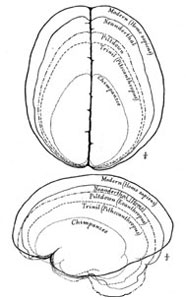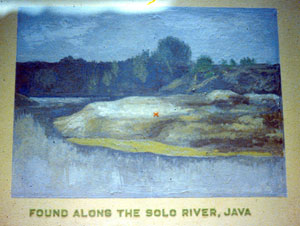
| Modern anthropology teaches that "man" has been developing for a very long
time -- as much as five million years. On the other hand, the Bible indicates
that man has only been around for a few thousand years. Can the two positions be
reconciled, or must one be rejected with only the other being acceptable? Which
position does the scientific evidence really support? How did modern
anthropologists arrive at their conclusions? Let us examine the origins of modern evolutionary thinking that is behind the theoretical statements about "early man" being hundreds of thousands of years old and some of the finds used to support this belief system; we will contrast them with the Biblical version of the origins of man. Man's Life Directly from God
The "Development" of Man Another area of major conflict between the Bible and evolutionary philosophy is in the development of man. Evolutionary anthropology postulates a scenario of early man as brutish with low intelligence. The theory is that over many tens or hundreds of thousands of years "man" evolved enough intelligence to move into caves, accidentally learned to make and use fire, and after tens of thousands of years as a hunter-gatherer, he eventually domesticated grain and animals. Of course, the accouterments of civilization did not appear until relatively recent times -- within the last five thousand years. The Biblical scenario is much different, with man highly intelligent from the beginning (Genesis 4:1-4). When Cain and Abel, the sons of Adam and Eve, came with their sacrifices, Cain was a "tiller of the ground." The text does not say that Cain brought in wild wheat or wild barley. It says he brought that which he had raised by farming, his produce of the ground = "domesticated" crops. Thus domesticated grain or vegetables are available at the beginning of man's existence. (The Hebrew is not clear as to what he actually brought.) Next, the text does not say that Abel brought wild sheep; it says he was a "keeper of sheep." He offered from the flocks of his field = "domesticated" animals -- in the very beginning. Domestication implies a long process of change from a wild to a tame state. But the Bible seems to imply that God created some things wild and some things for man's use -- already "domesticated," and intelligent man used them immediately. Even if God did create them "wild," Adam and his descendants"domesticated" them very early, not over a long period of time. In the Biblical account, man knew how to talk from the very beginning, knew how to use fire, knew how to do all kinds of things that we are given the impression took hundreds of thousands of years of evolutionary development. Not long after the events related in Genesis 4:1-16, Cain's close descendants exhibited all the elements of "civilization." Lamech's son, Jabal, was the "father" of those that live in tents and have livestock. This indicates knowledge of the cultivation of fibrous plants and weaving, and, of course, the continuation of raising domesticated animals. Jabal's brother, Jubal, was known as the developer of both stringed and wind musical instruments which would, of necessity, include the knowledge of music composition, and probably included other fine arts as well. A stepbrother, Tubal-cain, forged implements of bronze and iron. Bronze is not copper only; it is an alloy of both copper and tin. This indicates an early knowledge of smelting and metal combinations. And, with the knowledge of smelting, iron was already in use. So we see that according to the Bible, arts and industry had already developed during the very lifetime of the first man and woman -- Adam and Eve were still living at this time, as well as Cain. Can Discoveries of Early Man Be Reconciled with the Biblical Account? How can one reconcile scientific theories with the third and fourth chapters of Genesis, and even the second chapter of Genesis, where we have the activities of Adam and Eve and their children? These first people appear to be highly intelligent. They knew how to make fire from the very beginning -- they offered sacrifices. Furthermore, on the face of it, it seems that it was not very long ago. Can that be reconciled with modern archaeological discoveries? In what follows, we will examine the evidence presented for prehistoric man in museums in the U.S., and in the British Museum of Science. One should examine museum evidence for himself, being careful to read everything in the display captions. We will consider two models: one is the evolutionary model, the other is the creation model. If there is a third model, it might be that man came to earth from some other terrestrial body. But that possibility reverts to one or the other of the first two models. Either God made more beings or man evolved from some lower form of life. If evolution can be falsified and it can be shown that the evolutionary story for man's origin lacks evidence to support it, then one of the two models will have been displaced, leaving only one. It is not necessary to prove creation. Nor is it likely that we will find evidence for creation anywhere but in the Bible (except for several ancient near eastern creation myths); it happened such a long time ago. There can be no question that accepting the creation model is a matter of faith. On the other hand, evolution is a statement of faith also because, as will be seen, there is little, if any, evidence for it. Stone-Age Is Not Necessarily Early Was the Stone-Age a period of time long ago? Not necessarily, there are people living in the Stone-Age today in many places. They know how to make stone tools and weapons. Because people used stone implements does not mean they lived a very long time ago. Time magazine pictured people in Surinam who live in the stone-age. They are called "Stone-Age Tribesmen." In Mindanao, Philippines, National Geographic magazine (August 1972) introduced the world to the Tasaday people who live in caves and are in the Stone-Age. The title of the article was, "First Glimpse of a Stone Age Tribe." The Tasaday are stone-age cavemen, but they are intelligent people. They can make a fire by simply twisting a stick. They know a lot of other things that we do not know, we know a lot of things they do not know. The fact that they do not know what we know does not make them unintelligent. One must remember this concept as he investigates stone-age people. The following quotation from the National Geographic, (mentioned above) shows how completely fooled anthropologists were about the Tasaday,"They were making stone axes and, catching my fascinated stare, a man rose and brought them to me. They were crude, as crude as the oldest tools of the European Paleolithic." Paleolithic is the Old Stone-Age. "Paleo" is old; "lithic" is stone. These are not Neolithic -- New Stone-Age people, nor are they Mesolithic -- Middle Stone-Age people; they are Paleolithic. Yet, they are making implements today, this very moment, that as soon as they are finished, look to experienced anthropologists as though they are several hundred thousand years old! Since the intensive research on the Tasadays by experienced anthropologists was conducted, it has been discovered that the "stone-age" Tasadays of the Philippine Islands are frauds. They were only acting out the part of stone-age, cave men, apparently as a tourist gimmick. Yet they were the subject of a full length article with pictures in the National Geographic. They completely fooled experienced anthropologists who went to study them. But there are legitimate stone-age people today. In New Guinea, Borneo, Africa, Central America, and other places where civilization has not yet gone, men still use stone implements of all kinds. Throughout history, in every generation, some people have used stone implements and lived in caves. Not everyone, of course, but in any age there are always some stone-age cavemen. It was this way even as America developed. Indians used stone implements while "civilized" settlers used metal implements and firearms. It was true in the Middle Ages as well as at the turn of the first millenium. It was also true that, while the empires of Egypt and Mesopotamia flourished with high civilizations, some around them used stone implements and lived in caves. Even the Israelites lived in caves from time to time (Judges 6:2). Somehow, if one uncovers evidence of the stone-age, he has to prove that those remains are actually from a very long time ago by some other means than the fact that stone implements were in use. When caves are excavated, one should not assume that he will find remains of earliest, or even early, mankind. Finally, when it is said,"The Stone-Age was a period in man's development a long time ago -- hundreds of thousands of years ago -- now we are in the modern period," it is not necessarily so. Cavemen Today In Cappadocia, Turkey, a large area with unusual geological oddities has been developed as a cave-city. Everyone in the area lives in caves hand-hewn into these strange geological formations. But they have electricity and wear clothes. Actually it is a nice place to live. In the summer it is cool, and in the winter it is warm. No one thinks of these people as having regressed. As a matter-of-fact, these are very inexpensive dwelling places, unusually well insulated and highly habitable.
What I am trying to point out is that we are not so intelligent. We build our houses on top of a hill, and the wind and cold in the winter drive us out because it is so hard to heat. But cavemen, using their heads, utilized these ready-made shelters. They were every bit as intelligent as we are.
In Nazareth a huge church has been built over a cave because this cave was, traditionally, the grotto of Joseph and Mary, the cave where Jesus may have lived as a child. So Jesus, in one sense, could have been a "caveman." Whether it is true that Jesus actually grew up in this very cave or not, someone in Nazareth did. So much for Stone-Age caveman! Even though some people lived that way does not mean that they lived a long time ago, nor that these were brute hominids developing into Homo sapiens. Their remains, when found, may not be very old! An Evolutionary Myth
Now what do we make of the statement, "The larger the brain, the greater the intelligence?" If that were true, Neanderthal Man should have gone to the moon and we should be back in caves. How inconsistent the statement below the display is, compared with the actual display!
Impressions Rather than Facts
Evolutionists often deny that they say, "Man came from an ape." But in the British Museum of Science in London, one of the largest natural science museums in the world, a display once and for all belies that fact (assuming it is still there). No evolutionist should deny saying that man comes from an ape. Here, in a museum seen by thousands of people every year, a sign plainly says, "Man is an animal." In another section one discovers a caption claiming that "all human beings are animals, mammals, primates, and apes."
Another representation is found in the American Museum of Natural History in New York City. Here one can see a painted impression that man and ape come off the same stem (picture to left). It looks like they branched off from the same ape-like ancestor. But it does not display the missing links -- it is not a case of one "missing link"; there are no connections at all! Paucity of Evidence for Human Evolution A Time/Life children's book in the Emergence of Man series says, "It is now a proven scientific fact that man was millions of years in the making. The path of his evolution is marked by dead ends and new beginnings, the waysides strewn with relics of his various forms. Although many of these remains are at best minimal, they are enough to sketch out the key stages of his march through time. The chief problem facing anthropologists today is to fill in the gaps."Wait a minute! Read that first sentence again, then the last. How can it be a "proven fact" if the biggest problem is to fill in the gaps? Several museum displays will be examined to see what is used to prove human evolution. At Fossil Man's Hall of Fame in the Field Museum in Chicago, a caption reads, "In the study of human evolution there will always be room for differences of opinion and for doubt. Although occasional finds of fossil human remains may contribute greatly to knowledge of human development, theories of human evolution should not be based on specimens that are exceedingly fragmentary and lack important parts.Is evolution based on specimens that are exceedingly fragmentary and lack important parts, or do they really have solid evidence? The principles are: the evidence should not be fragmentary, and the specimens should not lack important parts. Let us examine the actual evidence -- from all over the world -- presented in museums. Most of the examples are well-known; almost everyone has heard of them. Java Man
But how did he find it? He dug through a gravel bed as big as a gymnasium for a full year, finding dozens of bones -- animal bones and human bones -- but he selected only three for Java Man. It was not a burial; they were just random bones, and probably the three bones are not even associated with each other. But he came back to Europe announcing, "Here is the missing link!" Today school children everywhere know about Java Man; they are told about it from the early grades in public schools.
The jaw bone has been judged by scientists to be a modern jaw bone. The skull cap has a low, sloping forehead. Dr. Dubois originally thought it was a human skull cap, but before he died, he finally agreed with his accusers that it was actually the skull cap of a gibbon, a great ape, and not human at all. Dr. Dubois claimed that Pithecanthropus erectus -- Java Man -- is a "missing link" 500,000 years old. Where did he get that figure? He simply pulled it out of the air; there is no support for it. Why must our children be required to learn about Java Man in school, as if he were one of the pillars of human evolution? The entire evidence available is only two modern bones and the skull cap of an ape, not even from a burial but found scattered throughout a gravel bed. It is ludicrous that anyone should be expected to believe that this is an authentic missing link. Peking Man Next, consider highly-touted Peking Man, supposedly 400,000 years old. What about him? We cannot show any remains of Peking Man because they were all lost in World War II. A display in the Field Museum in Chicago says 40 individuals were found. It says they were "from 350,000 to 500,000 years ago according to different geological estimates." What is another word for estimate? A "guess." They guess they are that old. But the next paragraph falsifies the first one because it says, "The cranial capacity of the known specimens range from 850 cc to 1,300 cc, an average of 1,075 cc; the upper end of the range overlaps with modem man." So they are small, modern men. The following paragraph reads, "The limb bones of Homo erectus, including both Java Man and the Peking varieties, are indistinguishable from those of modern man." So how can it be said they are 350,000 to 500,000 years old? They may be only a few thousand years old, for all we know. They are no different from modern man, so what does this show us about missing links and about human evolution? Nothing. The bones have disappeared anyway. So much for another pillar of human evolution - Peking Man! Nebraska Man
Piltdown Man
Take away Piltdown Man, wipe out Nebraska man, Java Man and Peking Man; they were all modern men or hoaxes. What is left of the original specimens used to formulate theories of human evolution? Not much. Heidelberg Man Heidelberg Man has been presented as one of the best examples of human evolution. All that is available, however, is a jaw supposedly 500,000 years old found in the 1860's in Germany. The jaw was found in a gravel quarry at a depth of about 80 feet. This quarry is located in a river valley. You would expect a river, the Neckar River in this case, to deposit many feet of gravel as it floods year after year. Instead of dating it 500,000 years old because the jaw was found 80 feet deep in river gravel, there is no reason to think it is more than a few thousand years old. For instance, in Korea we excavated some pottery from the pre-Christian era near the surface of the ground. But, in the nearby river bed, while excavating the basement for a bank building, the very same type of pottery was found at a depth of 25 feet -- 25 feet of deposit in only a little over two thousand years! Scientists generally agree that the Heidelberg jaw is modern. lts apparent young age does not support the theory of human evolution, even though it has been used as one of the main supports for it. Neanderthal Man
For many years, Neanderthal Man was represented as an imbecilic, bent-knee'd, stoop-shouldered type in the Field Museum in Chicago. But over the years researchers have developed a new view of Neanderthal Man. This new view is prevailing, fortunately. That is, that Neanderthal is really a modern man, one of us. Note the new display in the Field Museum showing an erect, intelligent person (picture at left). At the Smithsonian Institution (in Washington, DC) is this very important statement, "Because Neanderthal and modern man share these two important characteristics, an average brain size of 1,330 milliliters and burial of the dead, they can be grouped together in the same species, Homo sapiens"Neanderthals, then, were Homo sapiens -- modern man.
Neanderthal Man can no longer be a "missing link". Cro-Magnon Man with his sophisticated art forms and paintings (examples are well known cave paintings), is even more advanced than Neanderthal Man, and was obviously a highly intelligent race of modern man. What has happened to the pillars on which the original theories of human evolution were built? We have examined most of the evidence on which the theory was originally based, and found it entirely lacking. Other early examples only make the situation worse; later examples do not help the theory, rather they bring it more than ever into question. The Biblical Story of Man's Creation Has No Competitor There is no need to doubt what the Bible says about the creation of man. God created him out of the dust of the earth. It is a matter of faith; we cannot prove it. But our connection is with God, not with monkeys and apes. God made apes. He made man. But He did not take an ape and make a man. He made man special out of the dust of the earth and breathed into him the breath of life; so our life has come directly from the Lord. You and I are a special creation. Finally, for Christians, the special creation of Adam (the first man), by God, is of primary importance. Both Adam and Jesus must be historical persons for two reasons at least:
For Further Reading. "Getting at Our Roots," "Lucy and Dating Fossil Finds." 1991 ABR Newsletter, May-June. Bowden, M., 1977 Ape-Men: Fact or Fallacy? Kent, England: Sovereign Publ. Cousins, Frank W., 1971 Fossil Man. Emsworth, England: A.E. Norris & Sons. Gish, Duane T., 1985 Evolution: The Challenge of the Fossil Record. El Cajon, CA: Creation-Life Publ. Weiner, J.S., 1980 The Piltdown Forgery. New York: Dover Publ. |
....
Taken from: http://davelivingston.com/adamcaveman.htm



















No comments:
Post a Comment